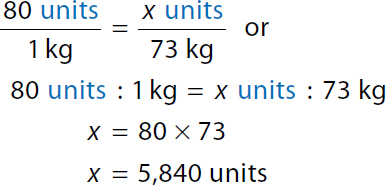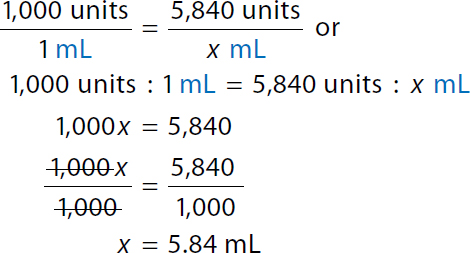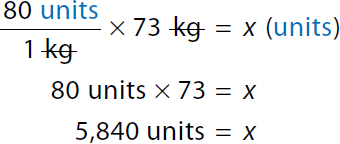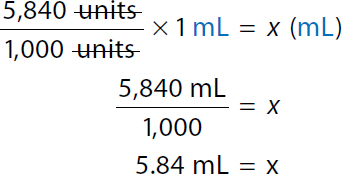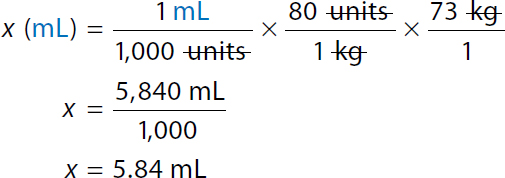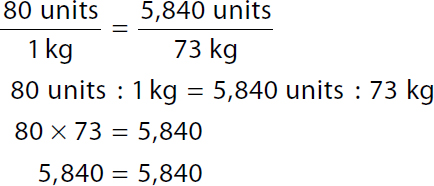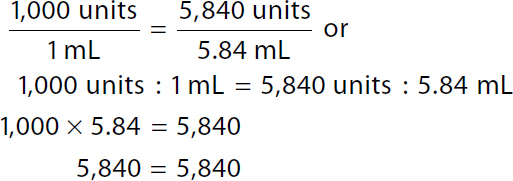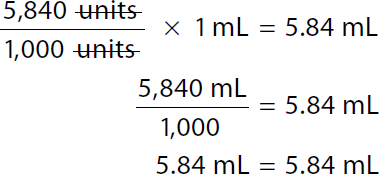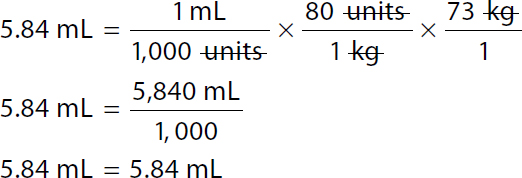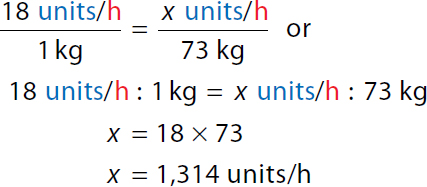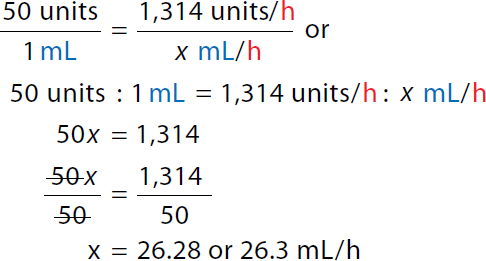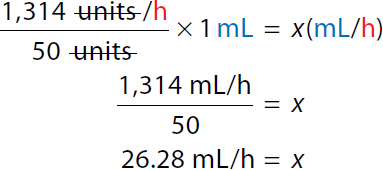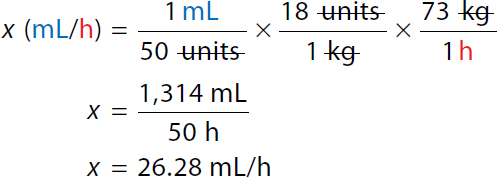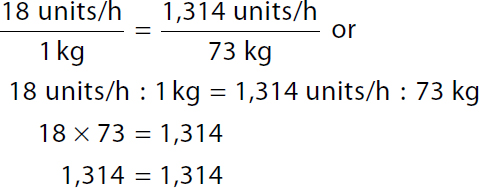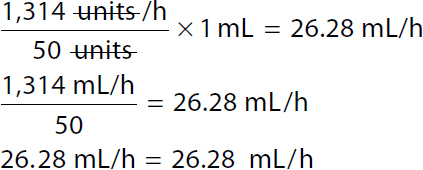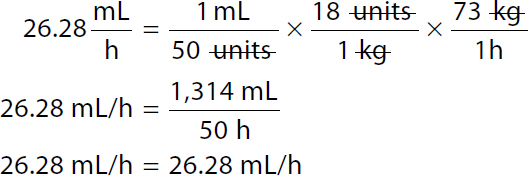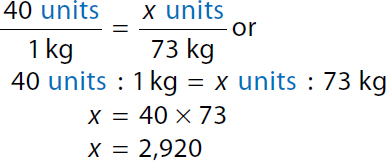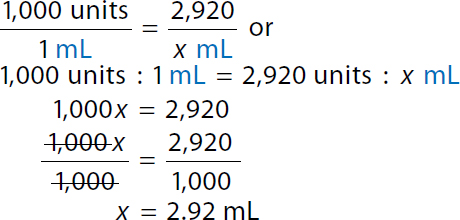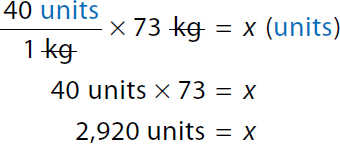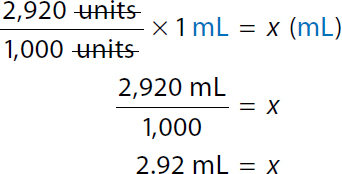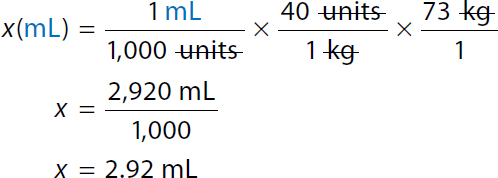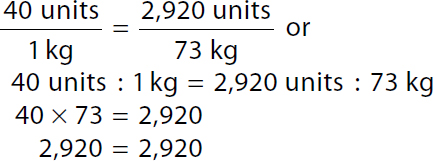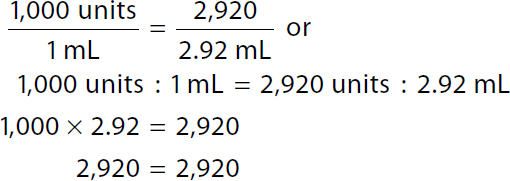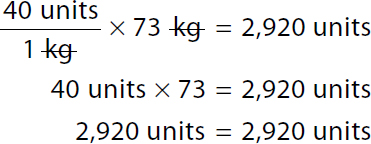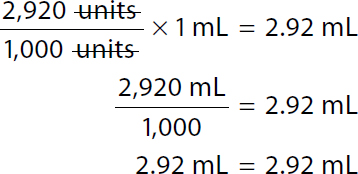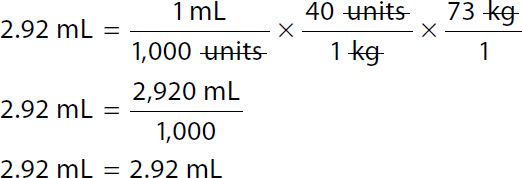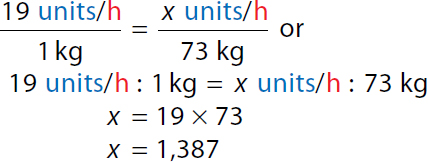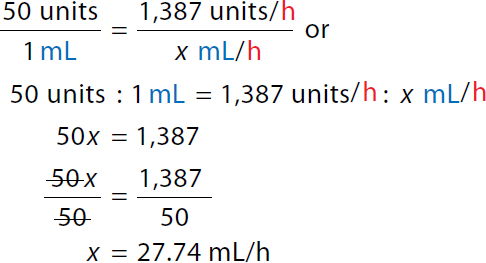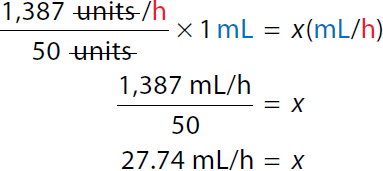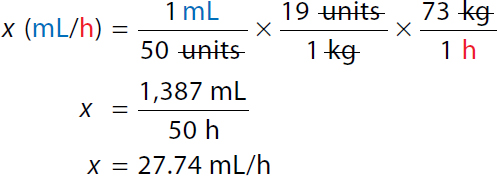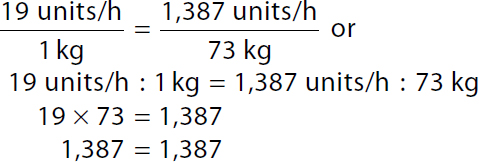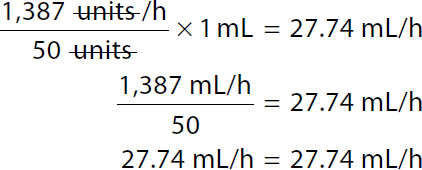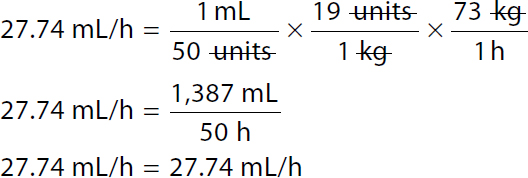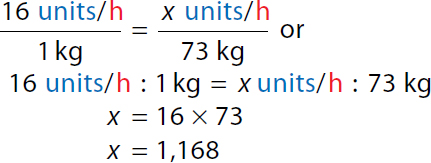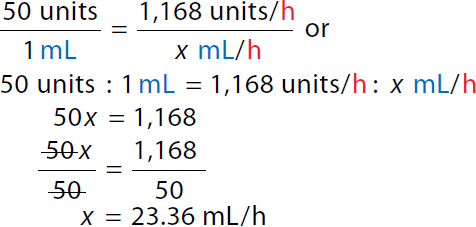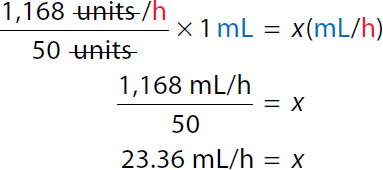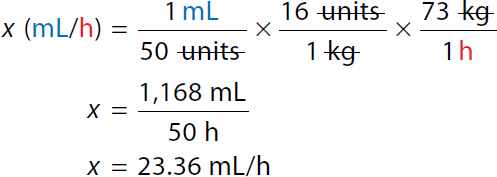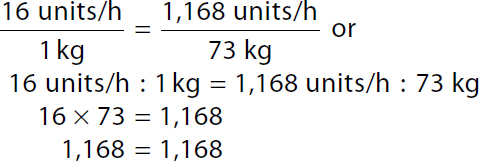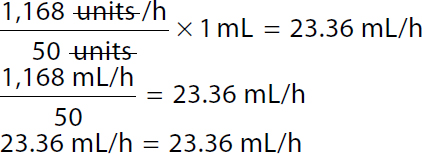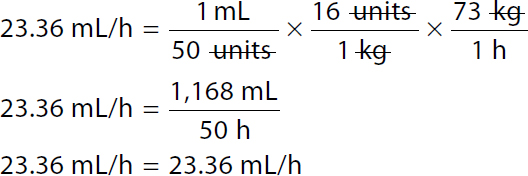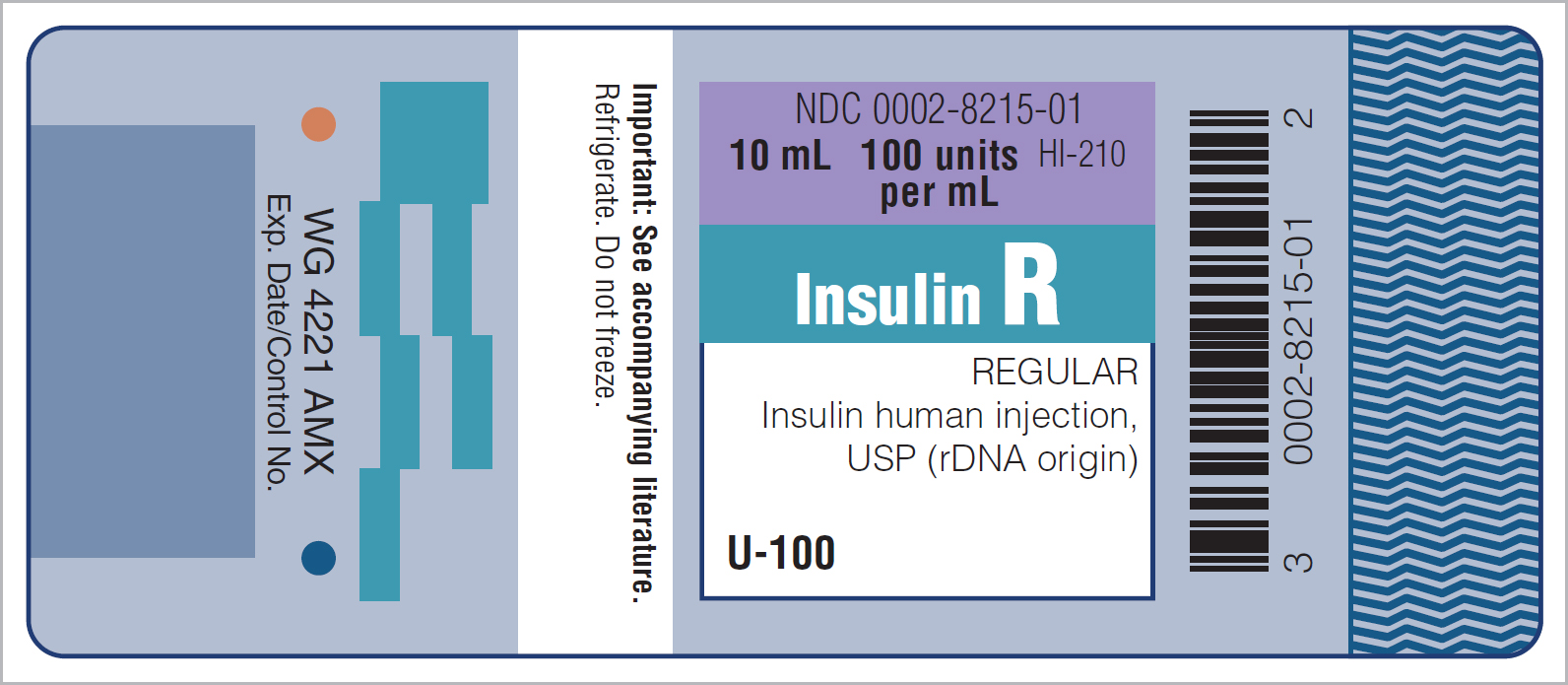
A weight-based heparin protocol is an order set of bolus doses and continuous infusion rates of IV heparin based on weight. Table 14-4 shows a protocol that prescribes weight-based IV boluses and continuous infusion rates that are adjusted based on the aPTT lab value. The frequency of aPTT blood testing is included in the protocol order set. A loading dose, the initial bolus dose, is given to achieve a therapeutic blood level, and the continuous infusion is given to maintain the therapeutic level. An alternative weight-based heparin protocol prescribes IV boluses and continuous infusion rates that are adjusted according to a lab value called "anti-factor Xa assay" (see Appendix G). This lab test measures heparin levels in plasma, whereas the aPTT lab test measures anticoagulation, the effect of heparin. Titration using the aPTT value is the principal method by which most laboratories monitor heparin therapy.
Heparin Protocol for DVT, PE, and High-Intensity Indications* Adjusted According to aPTT Goal aPTT 70–100 Seconds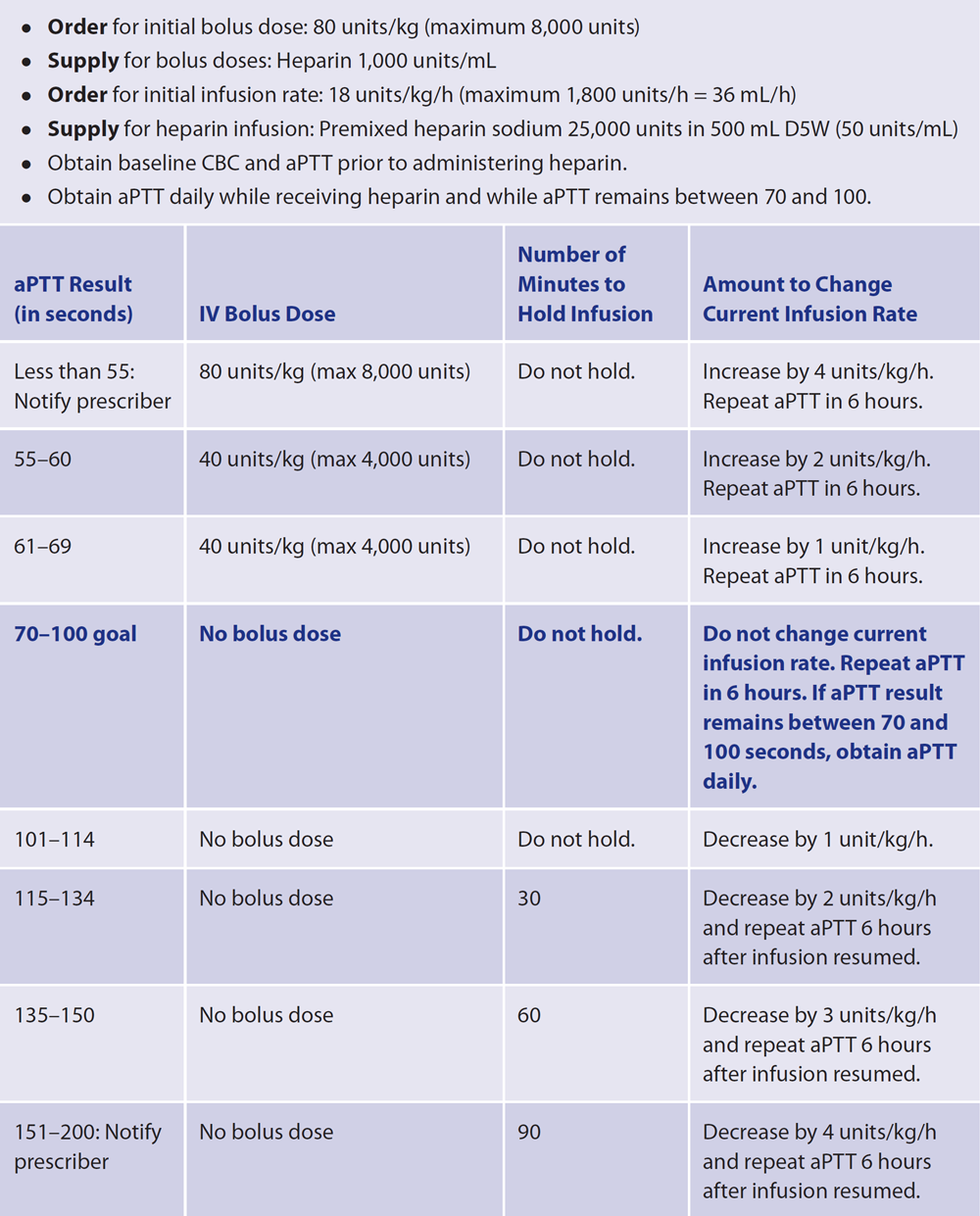
A table is titled Heparin Protocol for D V T, P E, and High-Intensity Indications, asterisk, Adjusted According to a P T T Goal a P T T 70 to 100 Seconds
Text above the table reads, Order for initial bolus dose: 80 units per kilogram, maximum 8,000 units. Supply for bolus doses: Heparin 1,000 units per milliliter. Order for initial infusion rate: 18 units per kilogram per hour, maximum 1,800 units per hour equals 36 milliliters per hour. Supply for heparin infusion: Premixed heparin sodium 25,000 units in 500 milliliters D 5 W, 50 units per milliliter. Obtain baseline C B C and a P T T prior to administering heparin. Obtain a P T T daily while receiving heparin and while a P T T remains between 70 and 100. The table consists of four columns: a P T T Result, in seconds; I V Bolus Dose; Number of Minutes to Hold Infusion; and Amount to Change Current Infusion Rate. The row entries are as follows. Row 1. Less than 55: Notify prescriber. 80 units per kilogram, max 4,000 units. Do not hold. Increase by 4 units per kilogram per hour. Repeat a P T T in 6 hours. Row 2. 55 to 60. 40 units per kilogram, max 8,000 units. Do not hold. Increase by 2 units per kilogram per hour. Repeat a P T T in 6 hours. Row 3. 61 to 69. 40 units per kilogram, max 4,000 units. Do not hold. Increase by 1 unit per kilogram per hour. Repeat a P T T in 6 hours. Row 4. 70 to 100 goals. No bolus dose. Do not hold. Do not change current infusion rate. Repeat a P T T in 6 hours. If a P T T result remains between 70 and 100 seconds, obtain a P T T daily. Row 5. 10 to 114. No bolus dose. Do not hold. Decrease by 1 unit per kilogram per hour. Row 6. 115 to 134. No bolus dose. 30. Decrease by 2 units per kilogram per hour and repeat a P T T 6 hours after infusion resumed. Row 7. 135 to 150. No bolus dose. 60. Decrease by 3 units per kilogram per hour and repeat a P T T 6 hours after infusion resumed. Row 8. 151 to 200: Notify prescriber. No bolus dose. 90. Decrease by 4 units per kilogram per hour and repeat a P T T 6 hours after infusion resumed. Text below the table reads, asterisk denotes Sample only: Not to be used in clinical practice. a P T T equals activated partial thromboplastin time; C B C equals complete blood count; D V T equals deep vein thrombosis; P E equals pulmonary embolism.
*Sample only: Not to be used in clinical practice.
aPTT = activated partial thromboplastin time; CBC = complete blood count; DVT = deep vein thrombosis; PE = pulmonary embolism

The protocol calls for an initial bolus dose of 80 units/kg. The initial bolus dose calculation is a two-step process.
Step 1: Calculate the weight-based bolus dose by multiplying the loading dose, 80 units/kg, by the patient's weight. Note that the maximum loading dose is 8,000 units.
Step 2: Calculate the volume to administer using the heparin supply of 1,000 units/mL.
Example 1A (Initial Bolus Dose and Volume Calculations): | Using the heparin protocol in Table 14-4, calculate the loading dose (initial bolus dose) for a patient weighing 73 kg. |
C: Convert—Because the order and the supply are both in units, there is no conversion.
A: Approximate
Step 1: The ordered dose is 80 units/kg and the patient weighs between 50 and 100 kg; therefore the patient will need between 4,000 and 8,000 units.
Step 2: Because there are 1,000 units of heparin per 1 mL, the volume to administer will be between 4 and 8 mL.
S: Solve
Ratio-Proportion | Formula Method |
|---|---|
Step 1: Calculate the bolus dose in units:
Calculation reads, 80 units over 1 kilogram equals x units over 73 kilograms or a ratio of 80 units to 1 kilogram equals ratio of x units to 73 kilograms. x equals 80 times 73. x equals 5,840 units. The patient's bolus dose is 5,840 units. Step 2: Calculate the volume to administer the bolus dose in mL:
To find the volume to administer the bolus dose. Calculation reads, 1,000 units over 1 milliliter equals 5,840 units over x milliliter or a ratio of 1,000 units to 1 milliliter equals ratio of 5,840 units to x milliliters. 1,000 x equals 5,840. 1,000 x over 1,000 equals 5,840 over 1,000. In both the numerator and the denominator 1000 canceled each other. x equals 5.84 milliliters. The volume to administer is 5.8 mL. | Step 1: Calculate the bolus dose in units:
Calculation reads, 80 units over 1 kilogram times 73 kilograms equals x of units. In both the numerator and the denominator kilogram canceled each other. 80 units times 73 equals x. 5,840 units equals x. The patient's bolus dose is 5,840 units. Step 2: Calculate the volume to administer the bolus dose in mL:
Calculation reads, 5,840 units over 1,000 units times 1 milliliter equals x of milliliter. In both the numerator and the denominator units canceled each other. 5,840 milliliters over 1,000 equals x. 5.84 milliliters equals x. The volume to administer is 5.8 mL. |
Steps 1 and 2 are combined:
A calculation to estimate the volume to administer the bolus dose using dimensional analysis. Calculation reads, x of milliliter equals 1 milliliter over 1,000 units times 80 units over 1 kilogram times 73 kilograms over 1. In both the numerator and the denominator units and kilograms canceled each other. x equals 5,840 milliliters over 1,000. x equals 5.84 milliliters The volume to administer is 5.8 mL. | |
E: Evaluate
Ratio-Proportion | Formula Method |
|---|---|
Step 1: Calculate the bolus dose in units:
Calculation reads, 80 units over 1 kilogram equals 5,840 units over 73 kilograms. Ratio of 80 units to 1 kilogram equals ratio of 5,840 units to 73 kilograms. 80 times 73 equals 5,840. 5,840 equals 5,840. Step 2: Calculate the volume to administer the bolus dose in mL:
Calculation reads, 1,000 units over 1 milliliter equals 5,840 units over 5.85 milliliters or a ratio of 1,000 units to 1 milliliter equals 5,840 units to 5.84 milliliter. 1,000 times 5.84 equals 5,840. 5,840 equals 5,840. | Step 1: Calculate the bolus dose in units:
Calculation reads, 80 units over 1 kilogram times 73 kilograms equals 5,840 units. In both the numerator and the denominator kilogram canceled each other. 5,840 units equals 5,840 units. Step 2: Calculate the volume to administer the bolus dose in mL:
Calculation reads, 5,840 units over 1,000 units times 1 milliliter equals 5.84 milliliters. In both the numerator and the denominator units canceled each other. 5,840 milliliters over 1,000 equals 5.84 milliliters. 5.84 milliliters equals 5.84 milliliters. |
Dimensional Analysis | |
Steps 1 and 2 are combined:
Calculation reads, 5.84 milliliters equals 1 milliliter over 1,000 units times 80 units over 1 kilogram times 73 kilograms over 1. In both the numerator and the denominator units and kilograms canceled each other. 5.84 milliliters equals 5,840 milliliters over 1,000. 5.84 milliliters equals 5.84 milliliters. | |
The calculated dose is less than the maximum dose, so the calculated dose can be administered. Because the calculated dose, 5,840 units, accurately completes the (Step 1) equation and is consistent with the approximated dose, the answer is confirmed. Because the calculated volume, 5.84 mL, accurately completes the (Step 2) equation and is consistent with the approximated volume, the rounded answer, 5.8 mL, is confirmed. The nurse will administer the 5.8 mL heparin bolus through the proximal IV access port on the primary IV tubing (Figure 14-51).
IV push or bolus medications are administered via the proximal IV access port.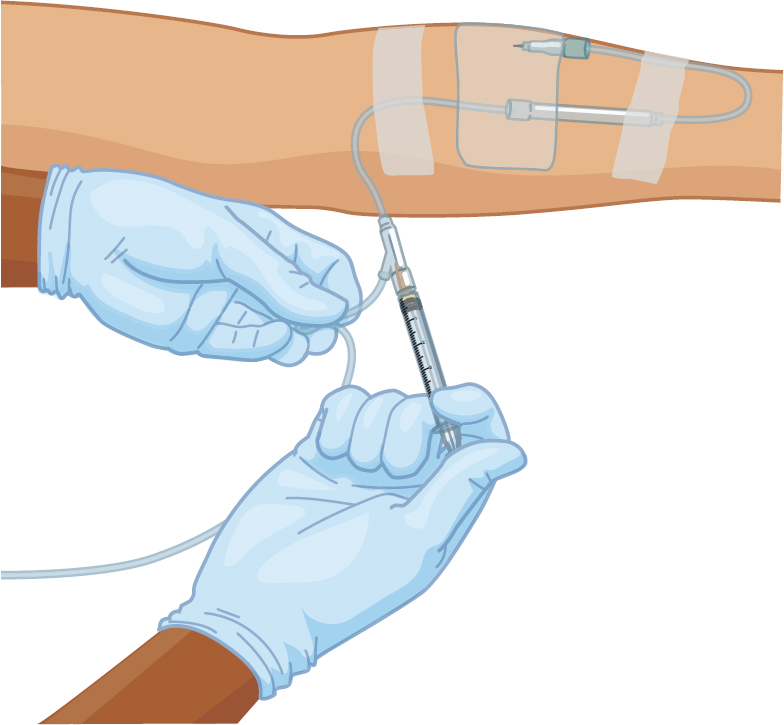
A diagram of a nurse administering medication from a syringe into an intravenous tube attached to the needle port inserted under the skin in the hand of a patient.
Clinical CLUE 14-7| Heparin boluses are adminstered undiluted over at least 1 minute in adults (Davis, 2023) and over 10 minutes in pediatric patients (PDR, 2023). |
The protocol calls for an initial weight-based hourly infusion dose of 18 units/kg/h with a maximum of 1,800 units/h (36 mL/h). The initial infusion rate calculation is a two-step process.
Step 1: Calculate the weight-based hourly infusion dose by multiplying 18 units/kg/h by the patient's weight.
Step 2: Calculate the IV infusion rate in mL/h using the supply of heparin 25,000 units in 500 mL of D5W 500 mL (50 units/mL).
Example 1B (Initial Infusion Dose & Rate Calculations): | Using the heparin protocol in Table 14-4, calculate the initial infusion rate for a patient weighing 73 kg. |
C: Convert—Because the order and the supply are both in units, there is no conversion.
A: Approximate
Step 1: The ordered dose is 18 units/kg/h, so the patient will need more than 730 units/h (10 units/h × 73 kg) but less than 1,460 units/h (20 units/h × 73 kg).
Step 2: Because there are 50 units of heparin per 1 mL, the rate to administer 730 – 1,460 units/h will be between 14 and 30 mL/h (i.e., 700 units/h divided by 50 units/mL = 14 mL/h; 1,500 units/h divided by 50 units/mL = 30 mL/h).
S: Solve
E: Evaluate
Ratio-Proportion | Formula Method |
|---|---|
Step 1: Calculate the infusion dose in units/h:
Calculation reads, 18 units per hour over 1 kilogram equals 1,314 units per hour over 73 kilograms or a ratio of 18 units per hour of 1 kilogram equals ratio of 1,314 units per hour of 73 kilograms. 18 times 73 equals 1,314. 1,314 equals 1,314. Step 2: To administer 1,314 units/h, calculate the infusion rate in mL/h:
Calculation reads, 50 units over 1 milliliter equals 1,314 units per hour over 26.28 milliliters per hour or a ratio of 50 units to 1 milliliter equals ratio of 1,314 units per hour to 26.28 milliliters per hour. 50 times 26.28 equals 1,314. 1,314 equals 1,314. | Step 1: Calculate the infusion dose in units/h:
Calculation reads, 18 units per kilogram per hour times 73 kilograms equals 1,314 units per hour. In both the numerator and the denominator kilograms canceled each other. 1,314 units per hour equals 1,314 units per hour. Step 2: To administer 1,314 units/h, calculate the infusion rate in mL/h:
Calculation reads, 1,314 units per hour over 50 units times 1 milliliter equals 26.28 milliliters per hour. In both the numerator and the denominator units canceled each other. 1,314 milliliters per hour over 50 equals 26.28 milliliters per hour. 26.28 milliliters per hour equals 26.28 milliliters per hour. |
Steps 1 and 2 are combined:
A calculation to evaluate the infusion dose using dimensional analysis. Calculation reads, 26.28 milliliters per hour equals 1 milliliter over 50 units times 18 units over 1 kilogram times 73 kilograms over 1 hour. In both the numerator and the denominator kilograms and units canceled each other. 26.28 milliliters per hour equals 1,314 milliliters over 50 hours. 26.28 milliliters per hour equals 26.28 milliliters per hour. | |
Because the calculated dose, 1,314 units/h, accurately completes the (Step 1) equation and is consistent with the approximated amount, the answer is confirmed. Because the calculated rate, 26.28 mL/h (rounded to 26.3 mL or 26 mL/h per pump calibration), accurately completes the (Step 2) equation and is consistent with the approximated rate, the answer is confirmed. The nurse will set the IV rate on the infusion pump to 26.3 mL/h (Figure 14-52).
After administering the heparin loading dose, the nurse will set the hourly infusion rate on the IV pump.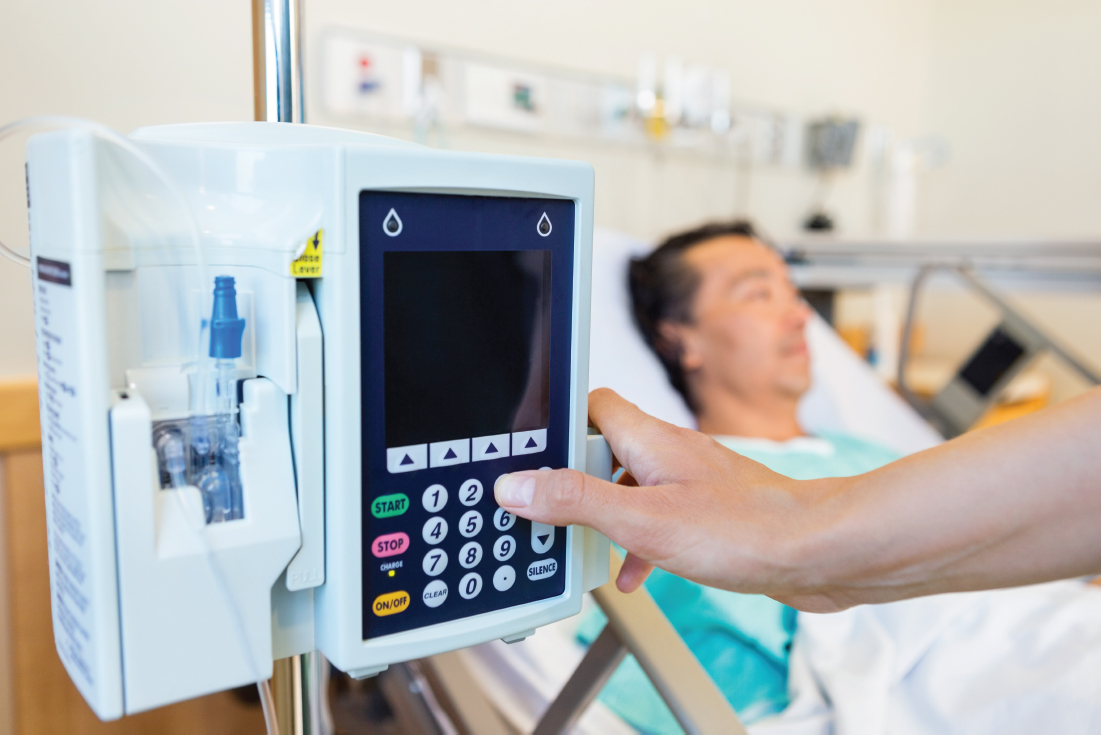
A photo features entering specific settings in an I V pump by pressing on the number buttons on the device. The I V pump is set up near the bed of a patient.
© Tyler Olson/Shutterstock
After the heparin protocol is initiated (i.e., after the loading dose is administered and the initial infusion rate is established), additional bolus doses will be administered and IV rate changes will be made according to aPTT results per the heparin protocol in Table 14-4. After an aPTT result is obtained, the nurse will determine:
- if an additional bolus dose is needed and calculate the bolus dose and volume, accordingly.
- the number of minutes to hold (stop) the infusion, if necessary.
- if the infusion rate requires adjustment (titration) and will calculate the titrated infusion dose and rate, accordingly.
Example 2A (Follow-up Bolus Dose & Volume Calculations): | The patient weighs 73 kg. The aPTT is 65 seconds. Using the heparin protocol (Table 14-4), calculate the: |
- Bolus dose in units
- Bolus amount (volume) in mL
Table 14-4 shows that with an aPTT of 65 seconds, the weight-based bolus dose will be calculated using 40 units/kg. The bolus amount (volume) will be calculated using the heparin supply of 1,000 units/mL:
C: Convert—Because the order and the supply are both in units, there is no conversion.
A: Approximate
Step 1: The ordered dose is 40 units/kg, and the patient weighs between 50 and 100 kg; therefore, the patient will need between 2,000 and 4,000 units.
Step 2: Because there are 1,000 units of heparin per 1 mL, the volume to administer will be between 2 and 4 mL.
S: Solve
Ratio-Proportion | Formula Method |
|---|---|
Step 1: Calculate the bolus dose in units:
Calculation reads, 40 units over 1 kilogram equals x units over 73 kilograms or ratio of 40 units to 1 kilogram equals ratio of x units to 73 kilograms. x equals 40 times 73. x equals 2,920. The patient's bolus dose is 2,920 units. Step 2: Calculate the volume to administer the bolus dose in mL:
Calculation reads, 1,000 units over 1 milliliter equals 2920 over x milliliter or ratio of 1,000 units to 1 milliliter equals 2,920 units to x milliliter. 1,000 x equals 2,920. 1000 x over 1000 equals 2920 over 1,000. In both the numerator and the denominator 1000 canceled each other. x equals 2.92 milliliters. The volume to administer is 2.9 mL. | Step 1: Calculate the bolus dose in units:
Calculation reads, 40 units over 1 kilogram times 73 kilograms equals x of units. In both the numerator and the denominator kilograms canceled each other. 40 units times 73 equals x. 2,920 units equals x. The patient's bolus dose is 2,920 units. Step 2: Calculate the volume to administer the bolus dose in mL:
Calculation reads, 2,920 units over 1,000 units times 1 milliliter equals x of milliliter. In both the numerator and the denominator units canceled each other. 2,920 milliliters over 1,000 equals x. 2.92 milliliters equals x. The volume to administer is 2.9 mL. |
Dimensional Analysis | |
Steps 1 and 2 are combined:
Calculation reads, x of milliliter equals 1 milliliter over 1,000 units times 40 units over 1 kilogram times 73 kilograms over 1. In both the numerator and the denominator units and kilograms canceled each other. x equals 2,920 milliliters over 1,000. x equals 2.92 milliliters. The volume to administer is 2.9 mL. | |
Ratio-Proportion | Formula Method |
|---|---|
Step 1: Calculate the bolus dose in units:
Calculation reads, 40 units over 1 kilogram equals 2,920 units over 73 kilograms or a ratio of 40 units to 1 kilogram equals ratio of 2,920 units to 73 kilograms. 40 times 73 equals 2,920. 2,920 equals 2,920. Step 2: Calculate the volume to administer the bolus dose in mL:
Calculation reads, 1,000 units over 1 milliliter equals 2,920 over 2.92 milliliters or ratio of 1,000 units to 1 milliliter equals ratio of 2,920 units to 2.92 milliliters. 1,000 times 2.91 equals 2,920. 2,920 equals 2,920. | Step 1: Calculate the bolus dose in units:
Calculation reads, 40 units over 1 kilogram times 73 kilograms equals 2,920 units. In both the numerator and the denominator kilograms canceled each other. 40 units times 73 equals 2,920 units. 2,920 units equals 2,920 units. Step 2: Calculate the volume to administer the bolus dose in mL:
Calculation reads, 2,920 units over 1,000 units times 1 milliliter equals 2.92 milliliters. In both the numerator and the denominator units canceled each other. 2,920 milliliters over 1,000 equals 2.92 milliliters. 2.92 milliliters equals 2.92 milliliters. |
Dimensional Analysis | |
Steps 1 and 2 are combined:
Calculation reads, 2.92 milliliters equals 1 milliliter over 1,000 units times 40 units over 1 kilogram times 73 kilograms over 1. Both numerator and denominator units and kilograms canceled each other. 2.92 milliliters equals 2,920 milliliters over 1000. 2.92 milliliters equals 2.92 milliliters. | |
The calculated dose is less than the maximum dose, so the calculated dose can be administered. Because the calculated dose, 2,920 units, accurately completes the (Step 1) equation and is consistent with the approximate volume, the answer is confirmed. Because the calculated volume, 2.92 mL, accurately completes the (Step 2) equation and is consistent with the approximated volume, the rounded answer, 2.9 mL, is confirmed.
EXAMPLE 2B (Titration Calculations for Infusion Dose & Rate): | The patient weighs 73 kg. The aPTT is 65 seconds. Using the heparin protocol (Table 14-4) determine: |
- the number of minutes to hold (stop) infusion, if necessary.
- hourly infusion dose in units/h.
- hourly infusion rate in mL/h.
With an aPTT of 65 seconds, the nurse determines:
- the infusion will not be held (stopped).
- the current weight-based infusion rate, 18 units/kg/h, will be increased by 1 unit/kg/h.
- the new infusion rate, 19 units/kg/h will be calculated using the IV solution (supply) of heparin 25,000 units in 500 mL D5W (50 units/mL).
C: Convert—Because the order and the supply are both in units, there is no conversion.
A: Approximate
Step 1: The ordered dose is 19 units/kg/h, so the patient will need more than 730 units/h (10 units/h times 73 kg) but less than 1,460 units/h (20 units/h times 73 kg).
Step 2: Because there are 50 units of heparin per 1 mL, the rate to administer 730 – 1,460 units/h will be between 14 and 30 mL/h (i.e., 700 units/h divided by 50 units/mL = 14 mL/h; 1,500 units/h divided by 50 units/mL = 30 mL/h).
S: Solve
Ratio-Proportion | Formula Method |
|---|---|
Step 1: Calculate the infusion dose in units/h:
Calculation reads, 19 units per hour over 1 kilogram equals x units per hour over 73 kilograms or ratio of 19 units per hour of 1 kilogram equals ratio of x units per hour of 73 kilograms. x equals 19 times 73. x equals 1,387. The patient's dose is 1,387 units/h. Step 2: To administer 1,387 units/h, calculate the infusion rate in mL/h:
A calculation to set the ratio-proportion to determine the infusion rate. Calculation reads, 50 units over 1 milliliter equals 1,387 units per hour over x milliliter per hour or a ratio of 50 units of 1 milliliter equals ratio of 1,387 units per hour of x milliliter per hour. 50 x equals 1,387. 50 x over 50 equals 1,387 over 50. In both the numerator and the denominator 50 canceled each other. x equals 27.74 milliliters per hour. The rate to deliver 1,387 units/h is 27.7 mL/h. | Step 1: Calculate the infusion dose in units/h:
Calculation reads, 19 units per kilogram per hour times 73 kilograms equals x of units per hour. In both the numerator and the denominator kilogram canceled each other. 1,387 units per hour equals x. The patient's dose is 1,387 units/h. Step 2: To administer 1,387 units/h, calculate the infusion rate in mL/h:
Calculation reads, 1,387 units per hour over 50 units times 1 milliliter equals x of milliliter per hour. In both the numerator and the denominator units canceled each other. 1,387 units per hour over 50 equals x. 27.74 milliliters per hour equals x. The rate to deliver 1,387 units/h is 27.7 mL/h. |
Dimensional Analysis | |
Steps 1 and 2 are combined:
A calculation to evaluate the infusion dose using dimensional analysis. Calculation reads, x of milliliter per hour equals 1 milliliter over 50 units times 19 units over 1 kilogram times 73 kilograms over 1 hour. In both the numerator and the denominator units and kilograms canceled each other. x equals 1,387 milliliters over 50 hours. x equals 27.74 milliliters per hour. The rate to deliver 1,387 units/h is 27.7 mL/h. | |
Ratio-Proportion | Formula Method |
|---|---|
Step 1: Calculate the infusion dose in units/h:
Calculation reads, 19 units per hour over 1 kilogram equals 1,387 units per hour over 73 kilograms or ratio of 19 units per hour of 1 kilogram equals ratio of 1,387 units per hour of 73 kilograms. 19 times 73 equals 1,387. 1,387 equals 1,387. Step 2: To administer 1,387 units/h, calculate the infusion rate in mL/h:
Calculation reads, 50 units over 1 milliliter equals 1,387 units per hour over 27.74 milliliters per hour or a ratio of 50 units of 1 milliliter equals ratio of 1,387 units per hour of 27.74 milliliter per hour. 50 times 27.74 equals 1,387. 1,387 equals 1,387. | Step 1: Calculate the infusion dose in units/h:
Calculation reads, 19 units per kilogram per hour times 73 kilograms equals 1,387 units per hour. In both the numerator and the denominator kilograms canceled each other. 1,387 units per hour equals 1,387 units per hour. Step 2: To administer 1,387 units/h, calculate the infusion rate in mL/h:
A calculation to find the infusion dose using Formula method. Calculation reads, 1,387 units per hour over 50 units times 1 milliliter equals 27.74 milliliter per hour. In both the numerator and the denominator units canceled each other. 1,387 milliliters per hour over 50 equals 27.74 milliliters per hour. 27.74 milliliters per hour equals 27.74 milliliters per hour. |
Dimensional Analysis | |
Steps 1 and 2 are combined:
A calculation to evaluate the infusion dose using dimensional analysis. Calculation reads, 27.74 milliliter per hour equals 1 milliliter over 50 units times 19 units over 1 kilograms times 73 kilograms over 1 hour. In both the numerator and the denominator units and kilogram canceled each other. 27.74 milliliters per hour equals 1,387 milliliters over 50 hours. 27.74 milliliters per hour equals 27.74 milliliters per hour. | |
Because the calculated dose, 1,387 units/h, accurately completes the (Step 1) equation and is consistent with the approximated rate, the answer is confirmed. Because the calculated rate, 27.74 mL/h (rounded to 27.7 mL/h), accurately completes the (Step 2) equation and is consistent with the approximated rate, the answer is confirmed.
Example 3 (Titration Calculations for Infusion Dose & Rate): | The patient weighs 73 kg. The aPTT is 135 seconds. The current weight-based heparin infusion rate, based on 19 units/kg/h, is running at 27.7 mL/h. Using the heparin protocol (Table 14-4) determine: |
- Number of minutes to hold the infusion, if necessary.
- Hourly IV infusion dose in units/h.
- Hourly IV infusion rate in mL/h.
With an aPTT of 135 seconds, there will be no bolus dose. The infusion will be held for 60 minutes, then decreased by 3 units/kg/h to 16 units/kg/h. To calculate the new infusion rate, use the heparin supply of 25,000 units in D5W 500 mL (50 units/mL).
C: Convert—Because the order and the supply are both in units, there is no conversion.
Step 1: The ordered dose is 16 units per kg/h, so the patient will need more than 730 units/h (10 units/h times 73 kg) but less than 1,460 units/h (20 units/h times 73 kg).
Step 2: Because there are 50 units of heparin per 1 mL, the rate to administer 730–1,460 units/h will be between 14 and 30 mL/h.
S: Solve
Ratio-Proportion | Formula Method |
|---|---|
Step 1: Calculate the infusion dose in units/h:
Calculation reads, 16 units per hour over 1 kilogram equals x units per hour over 73 kilograms or a ratio of 16 units per hour to 1 kilogram equals ratio of x units per hour to 73 kilograms. x equals 16 times 73. x equals 1,168. The patient's dose is 1,168 units/h. Step 2: To administer 1,168 units/h, calculate the infusion rate in mL/h:
A calculation to set the ratio-proportion to determine the infusion rate. Calculation reads, 50 units over 1 milliliter equals 1,168 units per hour over x milliliters per hour or a ratio of 50 units to 1 milliliter equals ratio of 1,168 units per hour to x milliliter per hour. 50 x equals 1,168. 50 x over 50 equals 1,168 over 50. In both the numerator and the denominator 50 canceled each other. x equals 23.36 milliliters per hour. To administer 1,168 units/h, set the rate to 23.4 mL/h. | Step 1: Calculate the infusion dose in units/h:
Calculation reads, 16 units per hour times 73 kilogram equals x units per hour over 1,168 units/ per hour equals x. The patient's dose is 1,168 units/h. Step 2: To administer 1,168 units/h, calculate the infusion rate in mL/h:
Calculation reads, 1,168 units per hour over 50 units times 1 milliliter equals x of milliliter per hour. In both the numerator and the denominator units canceled each other. 1,168 milliliters per hour over 50 equals x. 23.36 milliliters per hour equals x. To administer 1,168 units/h, set the rate to 23.4 mL/h. |
Dimensional Analysis | |
Steps 1 and 2 are combined:
Calculation reads, x of milliliter per hour equals 1 milliliter over 50 units times 16 units over 1 kilogram times 73 kilograms over 1 hour. In both the numerator and the denominator units and kilograms canceled each other. x equals 1,168 milliliters over 50 hours. x equals 23.36 milliliters per hour. To administer 1,168 units/h, set the rate to 23.4 mL/h. | |
Ratio-Proportion | Formula Method |
|---|---|
Step 1: Calculate the infusion dose in units/h:
Calculation reads, 16 units per hour over 1 kilogram equals 1,168 units per hour over 73 kilograms or a ratio of 16 units per hour of 1 kilogram equals 1,168 units per hour of 73 kilograms. 16 times 73 equals 1,168. 1,168 equals 1,168. Step 2: To administer 1,168 units/h, calculate the infusion rate in mL/h:
Calculation reads, 50 units over 1 milliliter equals 1,168 units per hour over 23.36 milliliter per hour or a ratio of 50 units to 1 milliliter equals ratio of 1,168 units per hour of 23.36 milliliters per hour. 50 times 23.36 equals 1,168. 1,168 equals 1,168. | Step 1: Calculate the infusion dose in units/h: 16 units/ Step 2: To administer 1,168 units/h, calculate the infusion rate in mL/h:
Calculation reads, 1,168 units per hour over 50 units times 1 milliliter equals 23.36 milliliters per hour. In both the numerator and the denominator units canceled each other. 1,168 milliliters per hour over 50 equals 23.36 milliliters per hour. 23.36 milliliters per hour equals 23.36 milliliters per hour. |
Dimensional Analysis | |
Steps 1 and 2 are combined:
Calculation reads, 23.36 milliliters per hour equals 1 milliliter over 50 units times 16 units over 1 kilogram times 73 kilograms over 1 hour. In both the numerator and the denominator units and kilogram canceled each other. 23.36 milliliters per hour equals 1,168 milliliters over 50 hours. 23.36 milliliters per hour equals 23.36 milliliters per hour. | |
Because the calculated dose, 1,168 units/h, accurately completes the (Step 1) calculation and is consistent with the approximated volume, the answer is confirmed. Because the calculated rate, 23.36 mL/h (rounded to 23.4 mL/h), accurately completes the (Step 2) equation and is consistent with the approximated rate, the answer is confirmed.
Examples 1A, 1B, 2A, 2B, and 3 are graphically explained in Figures 14-53, 14-54, and 14-55.
Initiation of Weight-based Heparin Protocol for a 73-kg Patient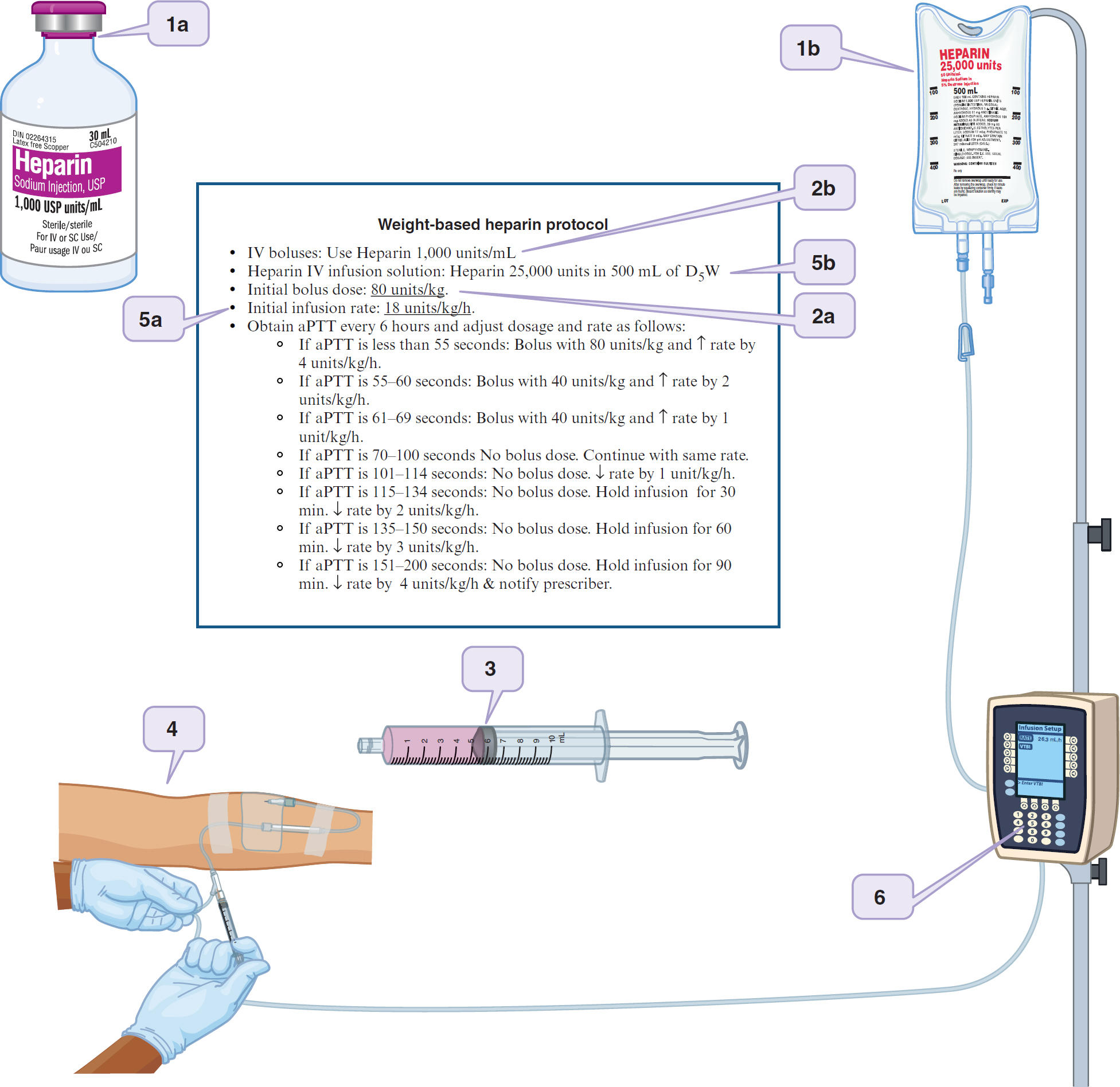
An illustration of the six weight-based heparin protocols for a 73-kilogram patient.
A callout labeled 1 a point to a 1,000 U S P units per milliliter, 30-milliliter heparin sodium injection, U S P vial. A callout labeled 1 b points to a 500-milliliter I V bag of heparin 25,000 units connected to an infusion pump labeled 6. A callout labeled 3 points to a syringe with medication 5.8 milliliter medication in a horizontal position without the needle and the plunger on its right. A callout labeled 4 points to a nurse administering medication through an intravenous tube in the hand of a patient. Text titled weight-based heparin protocol reads, I V boluses: Use Heparin 1,000 units per milliliter. Note: A callout labeled 2 b points to the previous sentence. Heparin I V infusion solution: Heparin 25,000 units in 500 milliliters of D subscript 5 W. Note: A callout labeled 5 b points to the previous sentence. Initial bolus dose: 80 units per kilogram. Note: A callout labeled 2 points to the previous sentence. Initial infusion rate: 18 units per kilogram per hour. Note: A callout labeled 5 points to the previous sentence. Obtain a P T T every 6 hours and adjust dosage and rate as follows: If a P T T is less than 55 seconds: Bolus with 80 units per kilogram and increase rate by 4 units per kilogram per hour. If a P T T is 55 to 60 seconds: Bolus with 40 units per kilogram and increase rate by 2 units per kilogram per hour. If a P T T is 61 to 69 seconds: Bolus with 40 units per kilogram and increase rate by 1 unit per kilogram per hour. If a P T T is 70 to 100 seconds No bolus dose. Continue with same rate. If a P T T is 101 to 114 seconds: No bolus dose. Decrease the rate by 1 unit per kilogram per hour. If a P T T is 115 to 134 seconds: No bolus dose. Hold infusion for 30 minutes. Decrease the rate by 2 units per kilogram per hour. If a P T T is 135 to 150 seconds: No bolus dose. Hold infusion for 60 minutes. Decrease the rate by 3 units per kilogram per hour. If a P T T is 151 to 200 seconds: No bolus dose. Hold infusion for 90 minutes. Decrease the rate by 4 units per kilogram per hour and notify prescriber.
Weight-based Heparin Protocol Titration (Adjustment) for a 73-kg Patient with aPTT 65 Seconds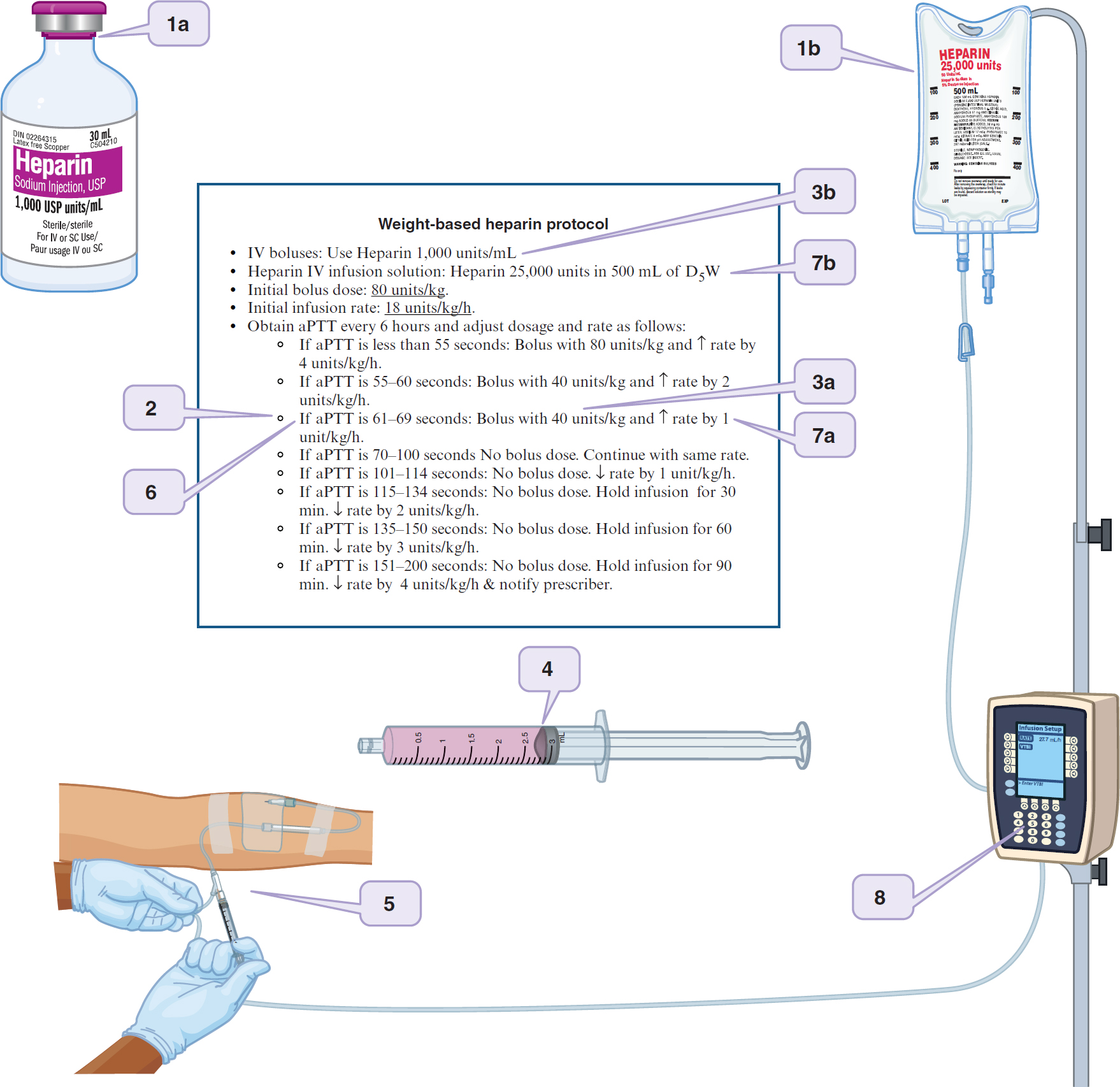
An illustration of the eight weight-based heparin protocols for a 73-kilogram patient.
A callout labeled 1 a point to a 1,000 U S P units per milliliter, 30-milliliter heparin sodium injection, U S P vial. A callout labeled 1 b points to a 500-milliliter I V bag of heparin 25,000 units connected to an infusion pump labeled 8. A callout labeled 4 points to a syringe with medication 2.8-milliliter medication in a horizontal position without the needle and the plunger on its right. A callout labeled 5 points to a nurse administering medication through an intravenous tube in the hand of a patient. Text titled weight-based heparin protocol reads, I V boluses: Use Heparin 1,000 units per milliliter. Note: A callout labeled 3 b points to the previous sentence. Heparin I V infusion solution: Heparin 25,000 units in 500 milliliters of D subscript 5 W. Note: A callout labeled 7 b points to the previous sentence. Initial bolus dose: 80 units per kilogram. Initial infusion rate: 18 units per kilogram per hour. Obtain a P T T every 6 hours and adjust dosage and rate as follows: If a P T T is less than 55 seconds: Bolus with 80 units per kilogram and increase rate by 4 units per kilogram per hour. If a P T T is 55 to 60 seconds: Bolus with 40 units per kilogram and increase rate by 2 units per kilogram per hour. If a P T T is 61 to 69 seconds: Bolus with 40 units per kilogram and increase rate by 1 unit per kilogram per hour. Note: Callouts labeled 2, 6, 3 a, and 7 a point to the previous sentence. If a P T T is 70 to 100 seconds No bolus dose. Continue with same rate. If a P T T is 101 to 114 seconds: No bolus dose. Decrease the rate by 1 unit per kilogram per hour. If a P T T is 115 to 134 seconds: No bolus dose. Hold infusion for 30 minutes. Decrease the rate by 2 units per kilogram per hour. If a P T T is 135 to 150 seconds: No bolus dose. Hold infusion for 60 minutes. Decrease the rate by 3 units per kilogram per hour. If a P T T is 151 to 200 seconds: No bolus dose. Hold infusion for 90 minutes. Decrease the rate by 4 units per kilogram per hour and notify prescriber.
Weight-based Heparin Protocol Titration (Adjustment) for a 73-kg Patient with aPTT 135 Seconds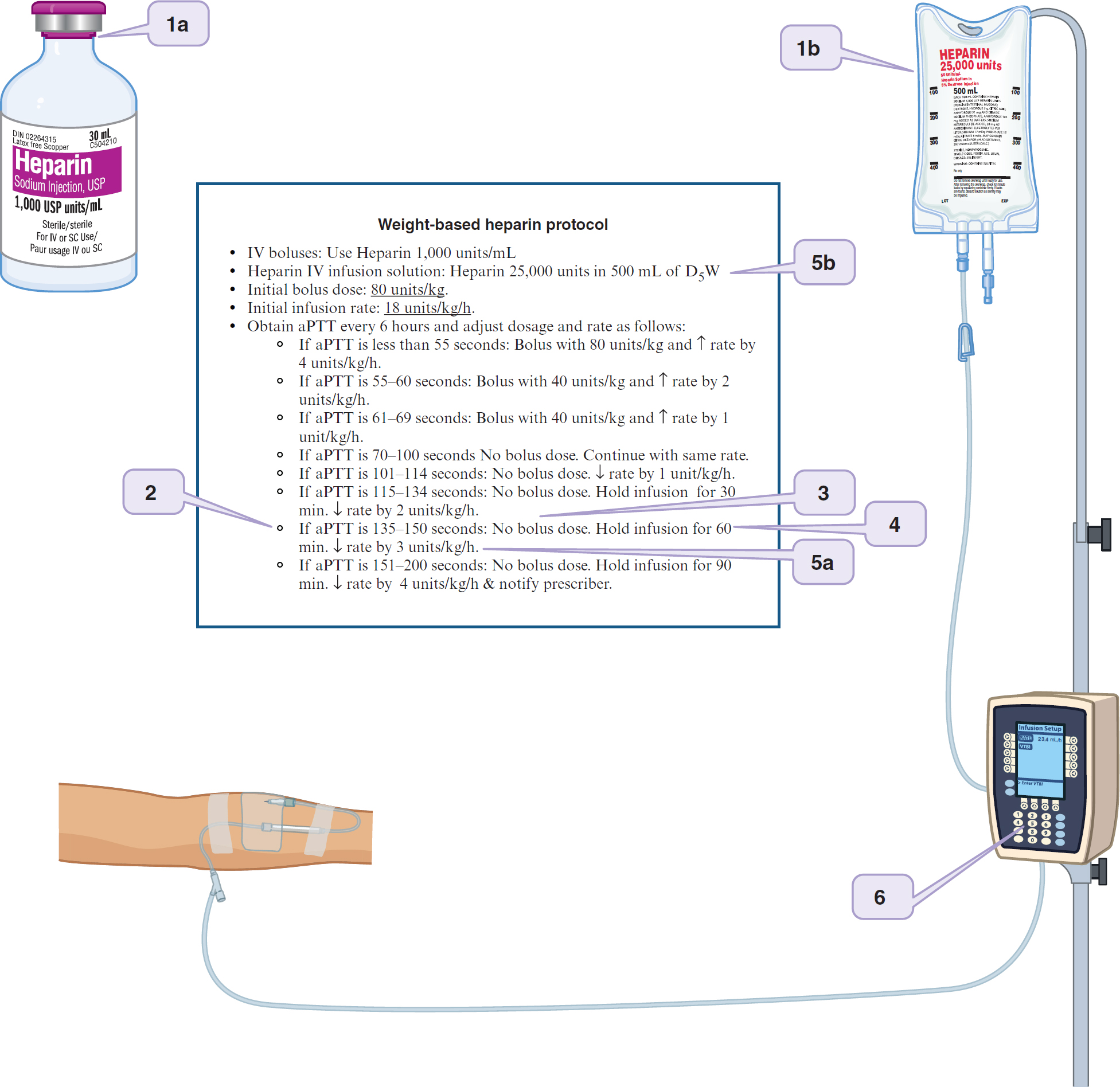
An illustration of the six weight-based heparin protocols for a 73-kilogram patient.
A callout labeled 1 a points to a 1,000 U S P units per milliliter, 30-milliliter heparin sodium injection, U S P vial. A callout labeled 1 b points to a 500-milliliter I V bag of heparin 25,000 units connected to an infusion pump labeled 6. The device administering medication and labeled 6 is connected through an intravenous tube to the hand of a patient. Text titled weight-based heparin protocol reads, I V boluses: Use Heparin 1,000 units per milliliter. Heparin I V infusion solution: Heparin 25,000 units in 500 milliliters of D subscript 5 W. Note: A callout labeled 5 b points to the previous sentence. Initial bolus dose: 80 units per kilogram. Initial infusion rate: 18 units per kilogram per hour. Obtain a P T T every 6 hours and adjust dosage and rate as follows: If a P T T is less than 55 seconds: Bolus with 80 units per kilogram and increase rate by 4 units per kilogram per hour. If a P T T is 55 to 60 seconds: Bolus with 40 units per kilogram and increase rate by 2 units per kilogram per hour. If a P T T is 61 to 69 seconds: Bolus with 40 units per kilogram and increase rate by 1 unit per kilogram per hour. If a P T T is 70 to 100 seconds No bolus dose. Continue at the same rate. If a P T T is 101 to 114 seconds: No bolus dose. Decrease the rate by 1 unit per kilogram per hour. If a P T T is 115 to 134 seconds: No bolus dose. Hold infusion for 30 minutes. Decrease the rate by 2 units per kilogram per hour. If a P T T is 135 to 150 seconds: No bolus dose. Hold infusion for 60 minutes. Decrease the rate by 3 units per kilogram per hour. Note: Callouts labeled 2, 3, 4, and 5 points to the previous sentence. If a P T T is 151 to 200 seconds: No bolus dose. Hold infusion for 90 minutes. Decrease the rate by 4 units per kilogram per hour and notify prescriber.
Clinical CLUE 14-8| When a calculated dose is higher than the maximum dose listed in the heparin protocol, the maximum dose should be administered, not the calculated dose. Double-check a "smart pump" to be sure the lower rate is infusing. These pumps have been known to increase the rate to that calculated by the pump, administering too much heparin to the patient. |
a. Heparin supply for bolus doses: 1,000 units/mL
b. IV solution for continuous/hourly dose: 500 mL D5W with 25,000 units of heparin (50 units/mL)
2. Calculate weight-based bolus dose and volume for a 73 kg patient (see Example 1A, steps 1 & 2, pp. 478-479):
a. Calculate bolus dose (80 units/kg) - 5,840 units
b. Use bolus supply (1,000 units/mL) to calculate bolus volume - 5.8 mL
3. From 1,000 units/mL heparin vial, draw up bolus dose, 5,840 units/5.8 mL, using 10-mL syringe.
4. Use 10 mL syringe to inject bolus dose 5,840 units/5.8 mL into proximal IV port.
5. Calculate weight-based infusion dose (units/h) and rate (mL/h) for a 73 kg patient (see Example 1B, steps 1 & 2, pp. 480-482).
a. Calculate initial continuous infusion dose (18 units/kg/h) - 1,314 units/h
b. Use IV solution/supply (50 units/mL) to calculate initial infusion rate - 26.3 mL/h
6. Use keypad on the infusion pump to set the initial infusion rate to 26.3 mL/h.
a. Heparin supply for bolus doses: 1,000 units/mL
b. IV solution for continuous/hourly dose: 500 mL D5W with 25,000 units of heparin (50 units/mL)
2. Look up aPTT result on Heparin Protocol to determine, if applicable:
a. Next weight-based bolus dose.
b. How long to hold infusion.
c. Amount to change current infusion rate.
3. If applicable, calculate next weight-based bolus dose and volume for a 73 kg patient (see Example 2A, steps 1 & 2, pp. 483-484):
a. Calculate bolus dose (40 units/kg) - 2,920 units
b. Use bolus supply (1,000 units/mL) to calculate bolus volume - 2.9 mL
4. From 1,000 units/mL heparin vial, draw up bolus dose, 2,920 units/2.9 mL using 3-mL syringe.
5. Use 3 mL syringe to inject bolus dose 2,920 units/2.9 mL into proximal IV port.
6. Since aPTT is 65 seconds, per protocol, determine that infusion will be held (stopped) for 0 minutes (do not hold).
7. Calculate weight-based infusion dose (units/h) and rate (mL/h) for a 73 kg patient (see Example 2B, steps 1 & 2, pp. 484-486).
a. Since aPTT is 65 seconds, initial infusion rate (18 units/kg/h) will be increased by 1 unit/kg/h. Calculate new continuous infusion dose (19 units/kg/h) - 1,387 units/h
b. Use IV solution/supply (50 units/mL) to calculate new infusion rate - 27.7 mL/h
8. Use keypad on the infusion pump to set the new infusion rate to 27.7 mL/h.
a. Heparin supply for bolus doses: 1,000 units/mL
b. IV solution for continuous/hourly dose: 500 mL D5W with 25,000 units of heparin (50 units/mL)
2. Look up aPTT result on Heparin Protocol to determine, if applicable:
a. Next weight-based bolus dose.
b. How long to hold infusion.
c. Amount to change current infusion rate.
3. Since aPTT is 135 seconds, per protocol, determine there is no additional bolus dose.
4. Since aPTT is 135 seconds, per protocol, determine that infusion will be held (stopped) for 60 minutes.
5. Since aPTT is 135 seconds, current infusion rate (19 units/kg/h) will be decreased by 3 units/kg/h. Calculate new weight-based infusion dose (units/h) and rate (mL/h) (see Example 3, steps 1 & 2, pp. 486-488).
a. Calculate new continuous infusion dose (16 units/kg/h) - 1,168 units/h
b. Use IV solution/supply (50 units/mL) to calculate new infusion rate - 23.4 mL/h
6. Use keypad on the infusion pump to set the infusion rate to 23.4 mL/h.
LEARNING ACTIVITY 14-10 Use the heparin protocol (Table 14-4) to calculate the bolus dose in units, bolus amount (volume) to administer in mL, hourly IV dose in units/h, and hourly IV rate in mL/h.
1. Calculate the loading dose and initial infusion rate for a patient weighing 103 kg.
Bolus dose: _______ Bolus volume: _______
Hourly IV dose: _______ IV rate: _______
2. Determine the protocol changes for a patient weighing 56 kg whose aPTT is 58 seconds and whose current heparin drip is infusing at 17 units/kg/h, including the length of time to hold the infusion, if necessary.
Bolus dose: _______ Bolus volume: _______
Hourly IV dose: _______ IV rate: _______
Minutes to hold infusion: _______
3. Calculate the following for a patient who weighs 65 kg:
a. initial bolus dose & volume to draw up
b. hourly IV dose and rate
c. bolus dose and volume for aPTT of 66 sec
d. hourly IV dose and rate for aPTT of 66 sec
Clinical CLUE 14-9| Different healthcare agencies may use different heparin protocols. Always follow the agency's protocol. Do not substitute one agency's protocol for another. |
| The nurse selected the wrong strength of insulin. The correct insulin was U-100 (100 units/mL) regular insulin (Figure 14-56). Because U-100 insulin syringes are designed to be used with U-100 concentration insulin, the dose was not accurately measured when U-500 insulin (500 units/mL) was used.U-100 regular insulin.
A label of U-100, 10-milliliter Insulin R injection. The text on the label reads, N D C 0002 8215 01. 10 milliliters. 100 units per milliliter. H I 210. Insulin R. Regular insulin human injection, U S P, r D N A origin, U 100. Important: See accompanying literature. Refrigerate. Do not freeze. W G 4221 A M X. Expiry date. Control number.
The patient received five times the appropriate dose of insulin. |
